













We conduct a technical SEO audit of your website to better understand your current SEO performance and develop a custom SEO strategy for your dental practice.

We identify the most relevant and high-performing keywords for your dental practice to improve your search engine rankings.

We conduct SEO competitor analysis to uncover your competitors' SEO performance, website content, on-page SEO, content gap, keyword gap, backlink strategies, and more.

We optimize your website content, meta tags, and images to ensure they align with your targeted keywords for maximum visibility.

Off-Page SEO involves strategies implemented outside your website to boost its visibility and authority in search engine rankings. Our off-page SEO services include local citation building, link building, and guest posting.

We develop a content strategy that aligns with your dental practice’s goals to attract and engage potential patients while enhancing your online authority.

We address any technical issues on your website, such as page load speed, mobile usability, and broken links, to improve user experience and search rankings.

We set up and optimise your Google Business Profile to make sure your practice appears in local searches when patients are looking for a dentist.

We provide regular reports that track key SEO metrics like keyword rankings, website traffic, and conversions, so you can easily monitor the progress and success of your SEO efforts.
Many agencies promise SEO success, but real growth happens only when strategy is built on hard evidence, not assumptions. At AdTuna, we power every SEO decision for your dental practice using real-time data, historical search behaviour, competitive analysis, and live performance tracking.
We dive deep into what patients are actually searching for, not what you assume they need. We identify precise keywords tied to real patient intent—whether it’s “same-day crowns near me,” “child-friendly dentist,” or “Invisalign consultations in Melbourne”—and build strategies around the search terms that lead to bookings.
By targeting real-world queries, we position your practice exactly where patients are ready to act, helping you attract high-quality leads who are actively looking for dental care today.




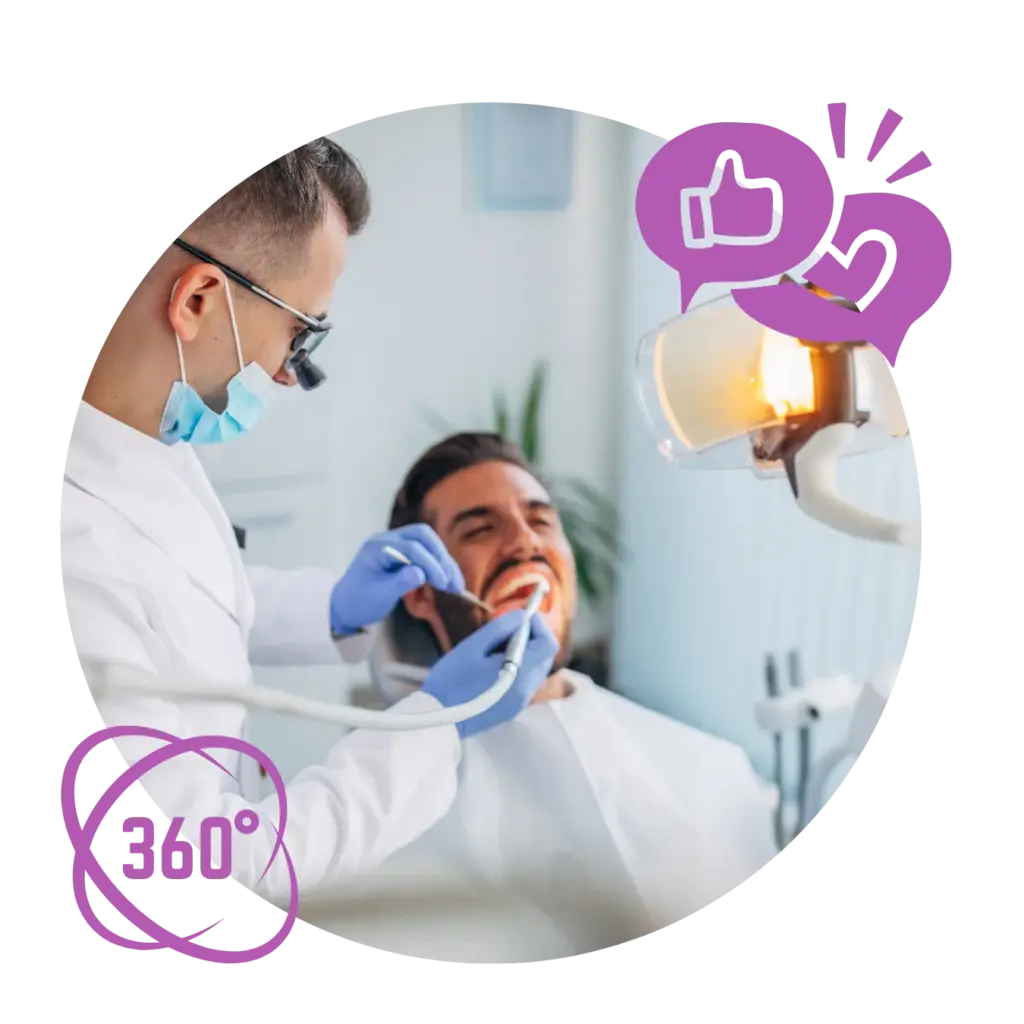
We optimise your website for high-intent, location-based keywords like “family dentist in Darwin” or “emergency dental clinic Melbourne,” helping you appear when patients are actively searching for a dentist in your area.
Ranking higher on Google means reaching patients who are already looking for services. These inbound leads are warmer, more qualified, and far more likely to turn into real bookings.
Patients trust businesses that rank at the top of search results. Strong SEO not only gets you seen—it builds credibility, helping your practice stand out as the first and most trusted choice in your community.
The patients who find you through organic search are ready to act. They're searching for solutions, not browsing casually. This means you close more enquiries, faster, without the heavy lifting.
Good SEO continues to drive traffic and enquiries long after the initial investment. Unlike paid ads that stop the moment you pause spending, SEO gives your practice a steady, cost-effective stream of new patients over time.
Many dental practices still focus only on word-of-mouth or short bursts of advertising. With data-driven SEO, you build a lasting competitive advantage—ranking higher, reaching more patients, and staying ahead before competitors even realise they're falling behind.
Let’s be honest — the dental industry is competitive, especially at a local level.
Patients aren’t flipping through directories or waiting for flyers in the mail anymore. They’re pulling out their phones, typing “best dentist near me” into Google, and making decisions in seconds based on what shows up. If your practice isn’t visible on that first page — preferably in the local map pack — then you’re already losing patients to the clinic down the street.
That’s where SEO comes in.
Search Engine Optimisation (SEO) is about more than just ranking higher on Google. For dental clinics, it’s a way to attract the right kind of patients — people in your local area who are actively looking for the services you offer, whether that’s teeth whitening, Invisalign, or a Saturday emergency appointment.
And here’s the good news: most dental practices haven’t nailed their SEO. They might have a website, sure. Maybe even a Google listing. But they’re missing the strategy — and that’s your opportunity to get ahead.
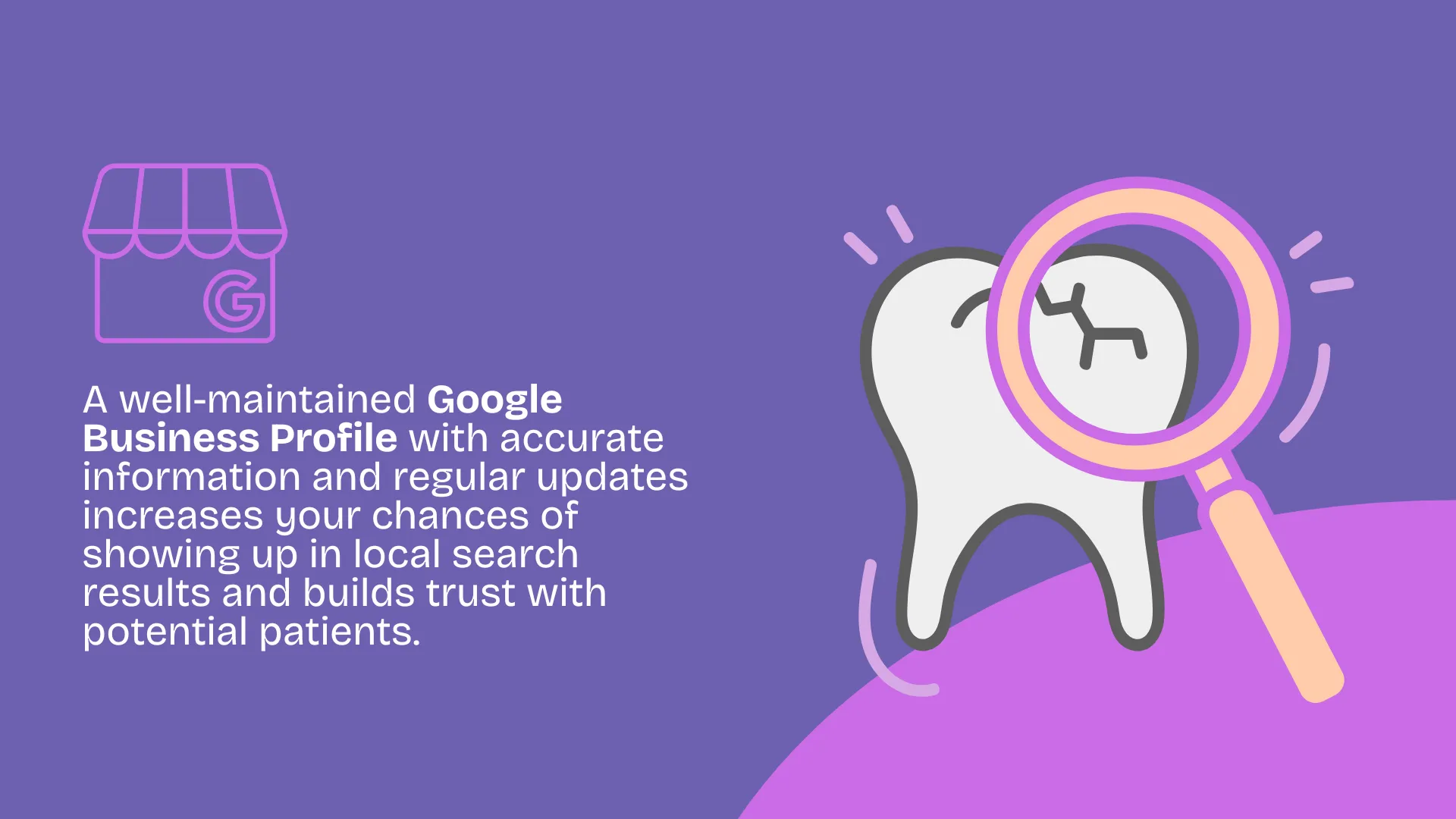
Think of your Google Business Profile (formerly Google My Business) as your clinic’s front window — but online. It’s often the first thing a potential patient sees when they search for a dentist in your area. And when it’s done right, it can be one of your most powerful tools for attracting local patients — without spending a cent on ads.
Why It Matters
When someone Googles something like “dentist in [your suburb],” Google often shows a map pack — those three listings with the map that sit above the regular search results. If your clinic isn’t there, you’re missing out on a huge share of local traffic. And to get there, your Google Business Profile needs to be properly optimised.
But here’s the catch: just having a profile isn’t enough. Most practices set it up once and forget about it — which means their competitors with actively managed listings are getting the clicks, calls, and bookings.
How to Optimise Your Profile (Properly)
Here’s how to turn your listing into a patient-generating machine:
1. Fill Out Every Detail
Make sure your Name, Address, and Phone Number (NAP) are 100% accurate — and match exactly what’s on your website. Google hates inconsistencies. Add your business hours, website URL, services, and appointment link if you have one.
Pro Tip: Use a tracking number that redirects to your main line if you want to monitor how many leads come from Google.
2. Choose the Right Categories
Your primary category should be something like “Dentist” or “Cosmetic Dentist,” depending on your core service. You can also add secondary categories like “Emergency Dental Service” or “Teeth Whitening Service” if they apply.
3. Add High-Quality Photos
Upload clear, professional photos of your clinic — inside and out. Show your staff, your equipment, your treatment rooms. It builds trust before a patient even steps inside. Listings with photos get significantly more clicks and direction requests.
4. Write a Compelling Business Description
Use this section to briefly explain who you are, where you’re located, and what you specialise in. Include a few relevant keywords naturally — like “family dental clinic in [suburb]” or “emergency dentist Gold Coast.”
5. Collect & Respond to Reviews
This is a big one. Encourage happy patients to leave honest Google reviews — and respond to every one of them, good or bad. It shows potential patients you care, and it tells Google your listing is active and trustworthy.
Bonus tip: Build the habit into your patient journey. A follow-up SMS or email after an appointment with a Google review link can work wonders.
When done well, your Google Business Profile doesn’t just help people find your clinic — it gives them a reason to trust and choose you. It’s one of the fastest, most effective local SEO wins you can make.
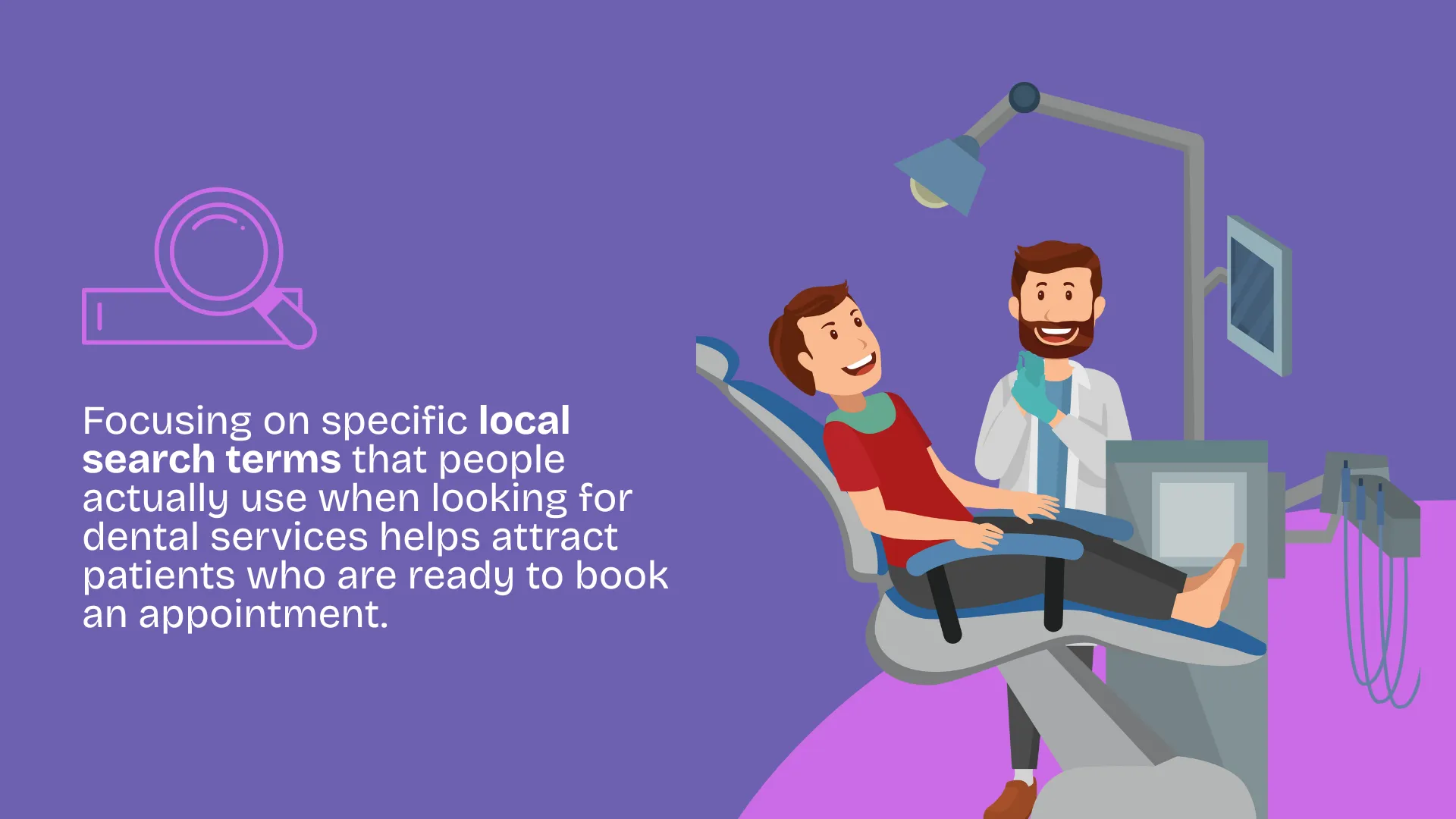
Let’s cut to the chase: if you’re not targeting the right keywords, you’re attracting the wrong traffic — or worse, no traffic at all.
When it comes to dental SEO, not all keywords are created equal. You don’t want just anyone visiting your site — you want people who are actively looking for a dentist in your area, ready to book an appointment. That’s where local, high-intent keywords come in.
What Are High-Intent Keywords?
High-intent keywords are the search terms people use when they’re close to making a decision — not just browsing. For example:
These are the kinds of searches that lead to real bookings, not just clicks. Compare that to vague terms like “dental care” or “oral hygiene” — which might bring in traffic, but rarely convert into patients.
How to Find the Right Keywords
You don’t need to be an SEO expert to do this. Start with tools like:
Make a list of your core services (e.g., teeth whitening, dental implants, general check-ups), then combine them with your suburb, city, or region.
Pro Tip: Don’t forget about “near me” keywords — Google understands location, and they convert well. For example: “dentist open late near me” or “bulk billing dentist near me.”
Where to Use These Keywords
Once you’ve got your list, it’s time to plug them into the right spots:
Keep It Natural
Yes, keywords matter. But this isn’t about stuffing “dentist Gold Coast” into every sentence. Google is smarter than that. Write naturally, for humans first — and search engines second. If your content clearly matches what someone’s looking for, Google will reward it.
Nailing your local keyword strategy helps you appear in exactly the searches your ideal patients are making. It’s targeted, trackable, and one of the most effective ways to bring in new bookings consistently.
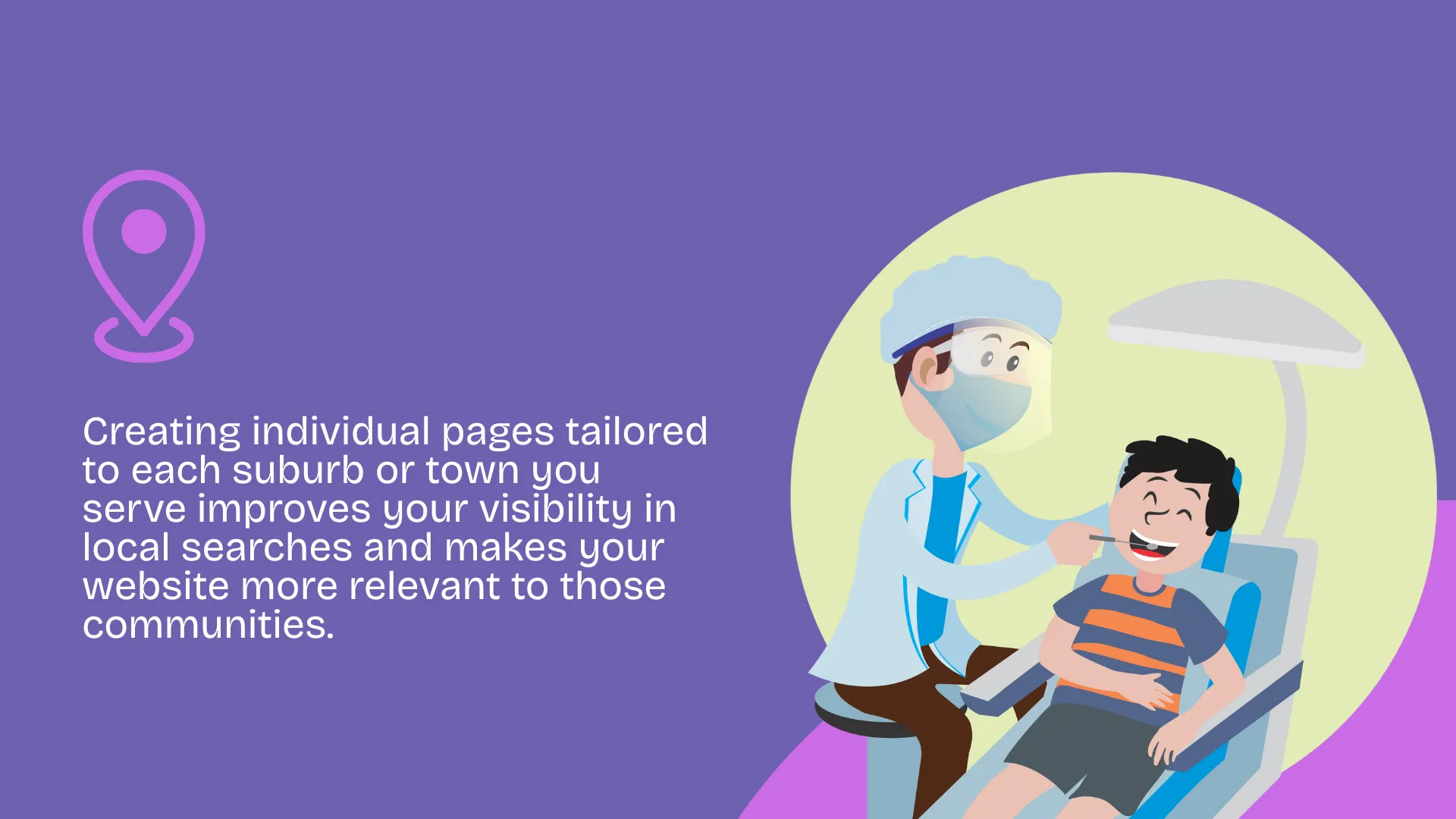
Here’s a simple truth: if you want to rank in more than one suburb or town, you need pages built for each location.
Most dental websites make one of two mistakes — either they list all their suburbs on a single “Service Areas” page, or try to rank one generic homepage for every search. Neither works well. Google wants to serve hyper-relevant, location-specific content to local searchers.
If someone in Manly, Sydney searches for “teeth whitening,” they want to see nearby clinics that speak directly to them — not a generic page that also mentions Bondi, Parramatta, and Chatswood.
What Are Location Pages?
Location-specific landing pages are dedicated pages on your website built around a particular suburb, town, or region you serve. Each one highlights your services, your local presence, and why you’re the right choice for patients there.
For example, instead of one “Dental Services” page, you might have:
What to Include on Each Page
Think of these pages like mini homepages but tailored to one location. Include:
A Clear, Location-Focused Headline
Use a keyword like “Trusted Dentist in [Suburb]” right at the top.
A Short Overview of Services
Mention your offerings and link to detailed treatment pages. For example:
“We provide general check-ups, fillings, and cosmetic procedures like Invisalign and teeth whitening — all conveniently located in Manly.”
Location-Specific Trust Signals
A Strong Local Call-to-Action
Encourage bookings with a clear CTA:
“Looking for a local dentist in Newtown? Book your appointment with us today.”
Avoid Copy-Paste Content
Don’t just swap suburb names on identical pages — write unique content for each location page. Google values originality and local relevance.
Creating location pages like these helps you rank for multiple areas, extend your reach across suburbs or towns, and show patients that you’re right there in their community.

Let’s face it — your potential patients aren’t just looking for a dental clinic; they’re searching for answers, reassurance, and advice. Creating helpful, relevant content on your website is one of the best ways to build trust and position your practice as the go-to expert in your area.
Why Content Matters for Dental SEO
Google loves websites that provide real value. When you publish content that answers common patient questions or addresses concerns, you’re not only helping people — you’re telling Google your site is authoritative and trustworthy.
For dental practices, this means you can attract visitors long before they’re ready to book. A blog post answering “How much does teeth whitening cost in Brisbane?” or “What to expect during your first Invisalign consultation in Melbourne?” can capture search traffic and bring patients into your funnel early.
What Types of Content Work Best
Educational Blog Posts
Write about common dental procedures, oral health tips, and lifestyle advice. For example:
FAQs
Create a dedicated FAQ section addressing questions like:
Video Content
Short videos explaining treatments or introducing your team can increase engagement and build trust.
Patient Stories & Testimonials
Sharing real patient experiences (with permission) adds authenticity and emotional connection.
Keep It Local
Try to weave local references naturally into your content. Mention your city or suburb when appropriate — for example, “Many patients in Adelaide ask about the best way to whiten their teeth before weddings.” This reinforces your local presence to Google and readers.
Update Your Content Regularly
SEO isn’t a set-and-forget game. Refresh older posts with new information, update statistics, and add new FAQs based on patient feedback. Regular updates signal to Google that your site is active and relevant.
Great content doesn’t just attract visitors — it keeps them coming back, builds trust, and encourages them to book. Plus, it’s a fantastic way to show off your practice’s personality and expertise.
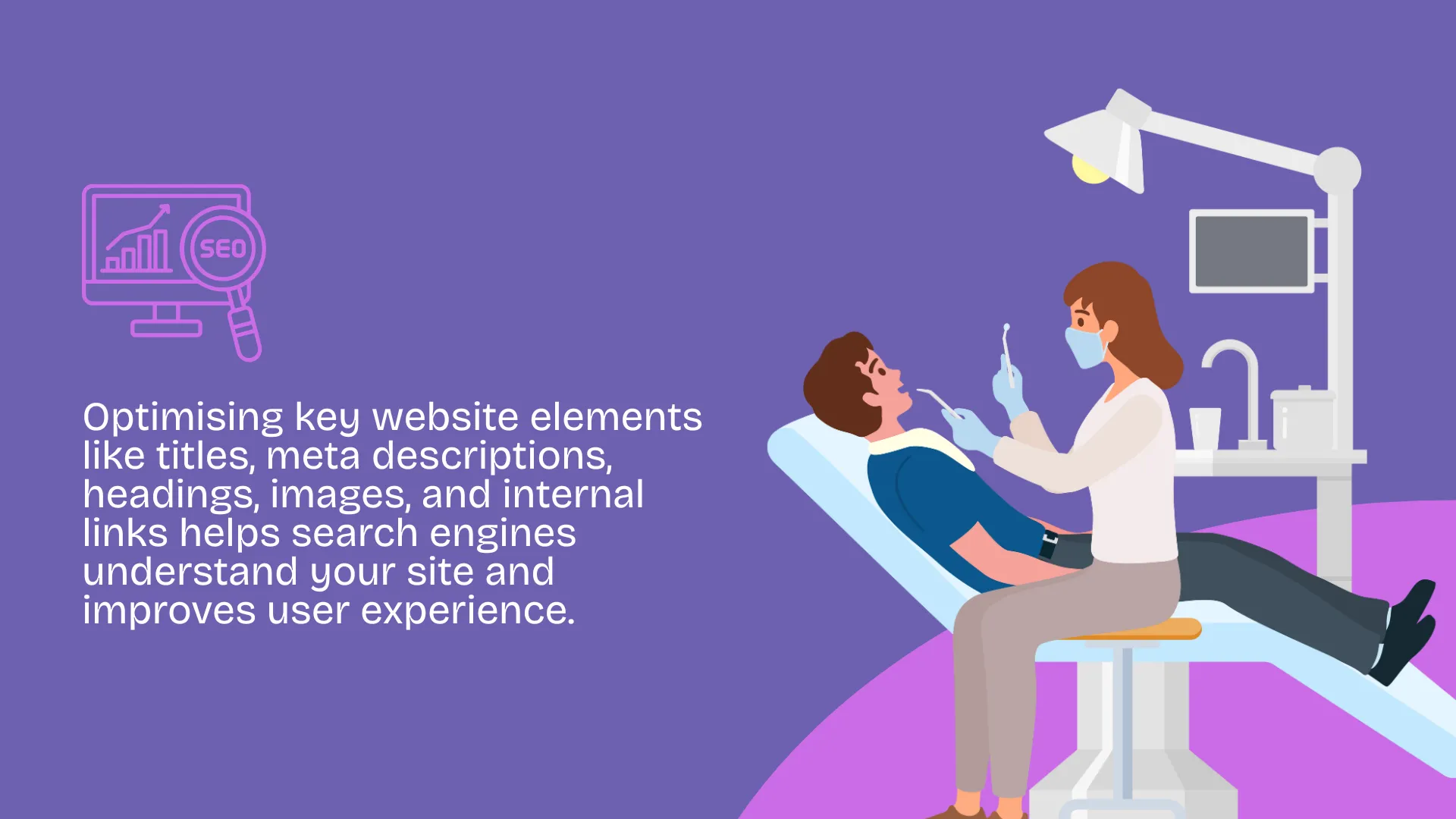
Think of on-page SEO as the nuts and bolts that keep your website working smoothly for both users and search engines. It’s about making sure every page is set up so Google understands what you offer and ranks you accordingly — while also giving visitors a great experience.
What On-Page SEO Covers
Here are the key elements you should focus on:
Title Tags
This is the clickable headline that appears on Google’s search results. Make sure each page has a unique title tag that includes your target keyword and location.
Example: “Affordable Family Dentist in Brisbane | Smile Bright Dental”
Meta Descriptions
The short snippet below the title tag in search results. Write compelling, clear descriptions that encourage clicks and include relevant keywords naturally.
Example: “Looking for a trusted dentist in Brisbane? Smile Bright Dental offers comprehensive family dental care. Book your appointment today!”
Header Tags (H1, H2, H3)
Use headers to break up your content and make it easy to scan. Your H1 should be the main headline of the page (ideally containing your primary keyword), and H2s/H3s should organise sections logically.
Image Alt Text
Search engines can’t “see” images, so alt text tells them what an image is about. Use descriptive, keyword-rich alt text for all photos on your site (e.g., “Dentist performing teeth cleaning in Melbourne clinic”).
URL Structure
Keep URLs clean, readable, and keyword-friendly.
Example: /cosmetic-dentistry-sydney is better than /page?id=1234
Internal Linking
Link relevant pages and blog posts to each other. For example, your “Teeth Whitening” service page should link to blog posts about whitening tips, and vice versa. This helps Google understand the relationship between your pages and improves user navigation.
Why It Matters
These on-page factors might seem technical, but they make a big difference. They help search engines figure out what your pages are about, improving your chances of ranking for the right terms. At the same time, clear titles, headers, and navigation keep visitors engaged — reducing bounce rates and increasing bookings.
Optimising these fundamentals is like tuning your website’s engine — it makes everything run smoother and helps your SEO efforts perform better overall.
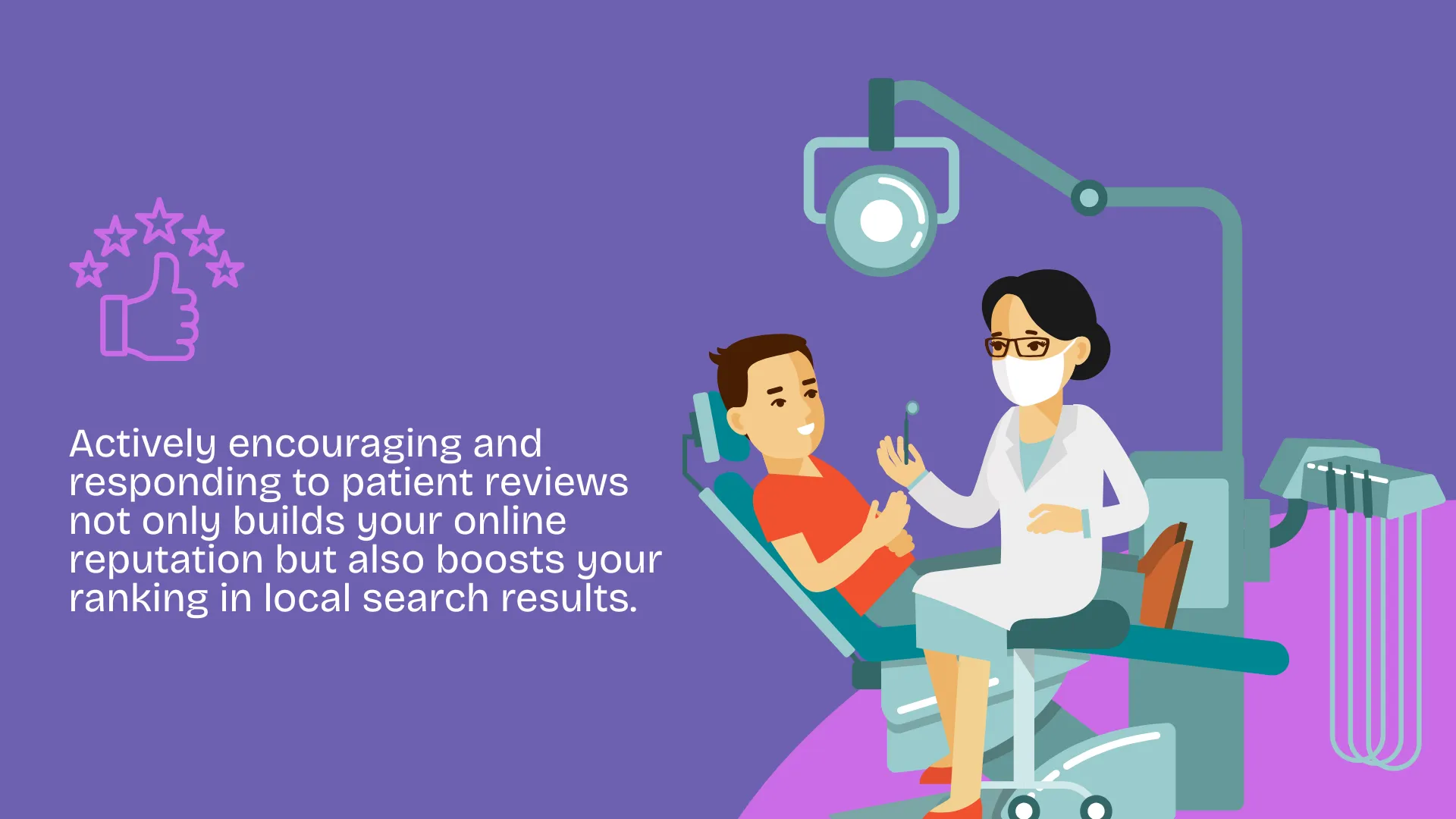
Patient reviews aren’t just “nice to have” — they’re one of the most powerful signals Google uses to rank local businesses. Plus, positive reviews build trust with prospective patients in a way that no marketing message can.
Why Reviews Matter
How to Get More Quality Reviews
How to Manage Your Online Reputation
By focusing on patient reviews and reputation management, you’ll boost your SEO, attract more patients, and build a trustworthy brand in your local community — all crucial for long-term growth.
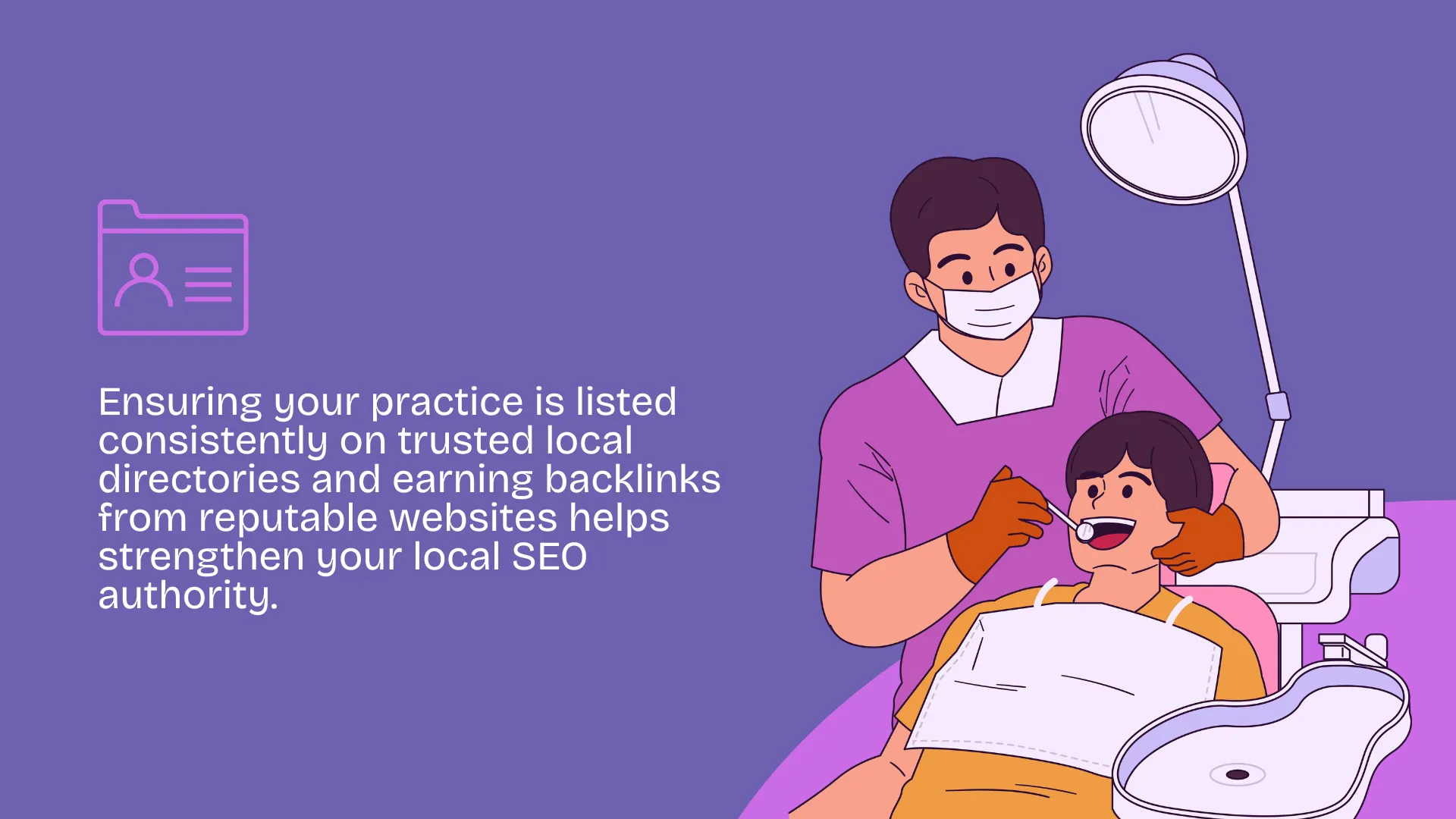
When it comes to local SEO, backlinks and citations are like votes of confidence from the internet. They tell Google your dental practice is reputable, trustworthy, and relevant to your community.
What Are Local Citations?
A citation is any online mention of your practice’s Name, Address, and Phone Number (NAP) — whether on business directories, local listings, or niche dental platforms. Consistent citations across trusted sites boost your local rankings.
Key Australian Citation Sites for Dentists
Make sure your practice is listed (with consistent details) on:
How to Build Quality Backlinks
Backlinks are links from other websites to yours, and quality beats quantity every time.
Why It Matters
Google views citations and backlinks as endorsements. The more quality references your practice has around the web — especially on relevant local sites — the more authority you build, which helps you rank higher in search results.
Focus on building genuine, local connections online. It’s a slower game than some SEO tactics, but the payoff in credibility and rankings is worth it.
SEO for dental practices isn’t a quick fix — it’s a long-term strategy that, when done right, pays off in a steady stream of new patients and stronger local presence.
By optimising your Google Business Profile, targeting the right local keywords, building location-specific pages, and creating valuable patient-focused content, you’re setting a solid foundation. Layer in on-page SEO best practices, a smart approach to reviews and reputation management, plus building citations and backlinks, and you’ll be miles ahead of most clinics competing for the same patients.
Remember, SEO isn’t just about rankings. It’s about making it easier for the right people to find and trust your practice — so they choose you when it’s time to book their next appointment.
Start applying these strategies today, track your progress, and watch your online visibility — and your patient numbers — grow.
Need help getting your dental SEO strategy off the ground? Feel free to reach out — we’re here to help you succeed.

Patients don’t find dentists by walking past clinics anymore—they find them by searching online. SEO places your practice where it matters most: on Google, when local patients are ready to book.
Without SEO, even the best clinics lose enquiries to competitors with stronger digital visibility. SEO builds your online presence across search engines, Maps, and local listings, helping you reach patients before they even call another dentist.
It’s not just about ranking high—it’s about creating an online footprint that grows patient trust, drives consistent bookings, and future-proofs your clinic against changing markets. In today’s world, no SEO means no visibility—and no visibility means no growth.
Dental SEO focuses on winning local patients who are ready to book, not building general website traffic. Patients looking for dental services usually search with urgency—whether they need emergency treatment, cosmetic care, or a new family dentist. SEO for dental clinics must be sharper, faster, and more trust-focused than standard SEO.
Here’s what makes dental SEO different:
General SEO may chase broad visibility and traffic, but dental SEO ties success directly to real-world outcomes: phone calls, bookings, and patient loyalty.
Dental SEO is a long-term growth strategy, not an overnight fix. Most practices start seeing early movement within a few months, but strong, sustainable results usually take between 6 to 12 months depending on your starting point, competition, and how aggressive your SEO strategy is.
Key factors that affect how fast you see results include:
Good SEO builds momentum over time. The longer you invest in it, the more your rankings, enquiries, and patient loyalty grow—without relying on constant ad spending.
Both SEO and Google Ads can help your practice grow, but they work differently. Google Ads delivers fast visibility by placing your clinic at the top of search results through paid advertising, while SEO builds long-term, organic visibility that keeps working even when you stop paying for ads.
Here’s how they compare:
Choosing between them isn’t about picking one—it’s about balancing short-term wins with long-term growth for the strongest overall results.
On-page SEO focuses on optimising elements on your website like content, keywords, meta tags, and page structure. Off-page SEO focuses on building your website’s authority through backlinks, Google Business Profile, online reviews, and other external signals.
We offer complete dental website design and redesign services alongside our SEO work. If your current website is outdated, slow, difficult to use, or not built for SEO, we recommend a full upgrade to support your growth goals. A strong, modern website is critical for ranking higher, building trust with patients, and turning visitors into bookings.
When we redesign your dental website, we focus on:
Whether you need a few improvements or a completely new build, we create dental websites that look professional, load fast, and help grow your patient base.